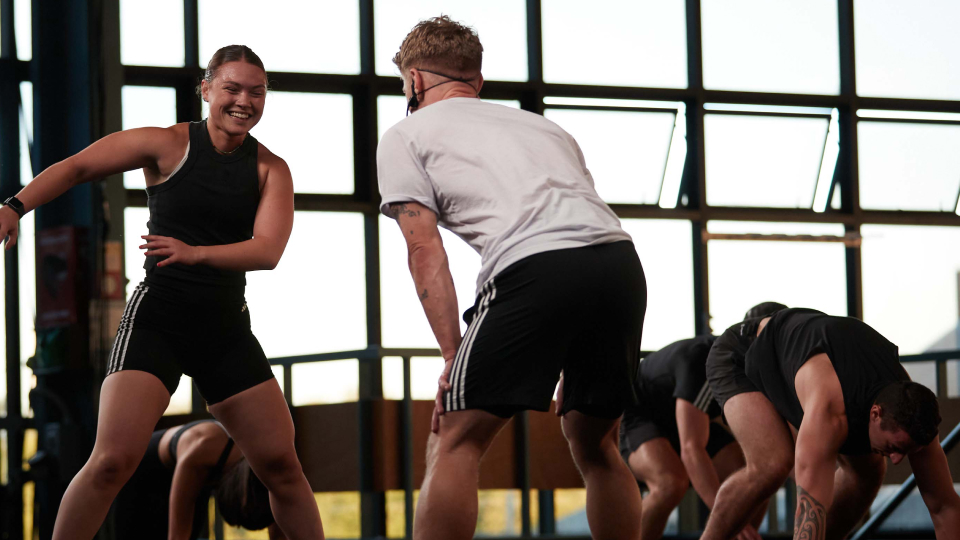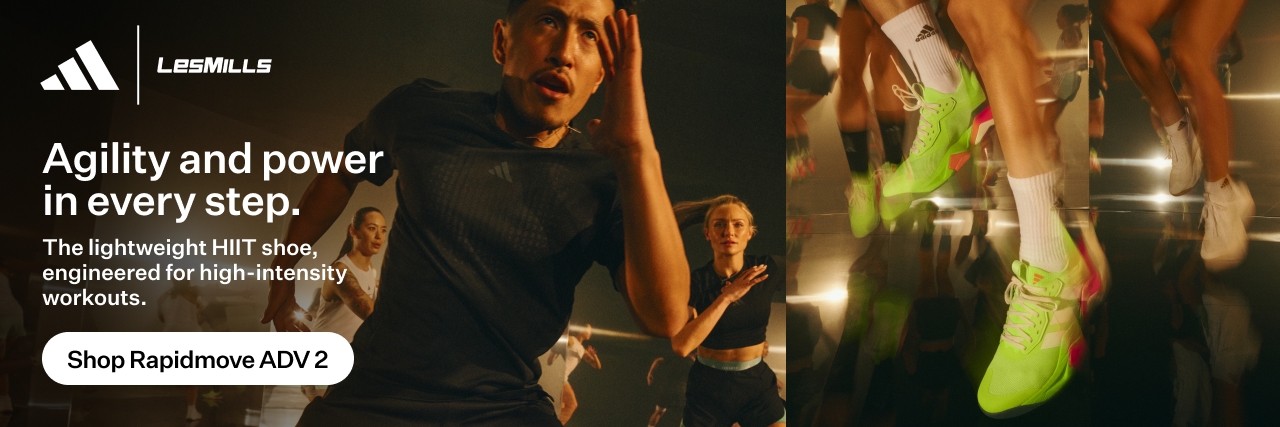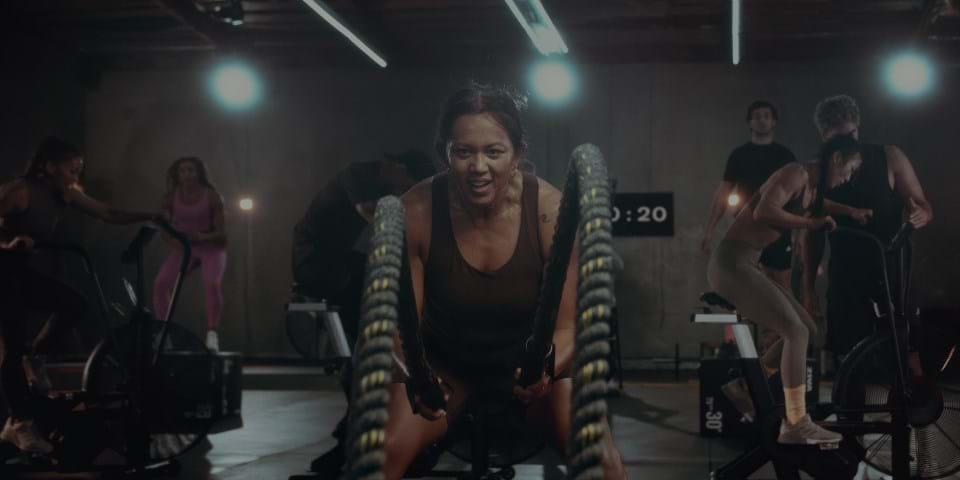When you're in the midst of a hot and sweaty HIIT workout, all sorts of mind games can kick in. You might mentally check out, mindfully count down seconds, or channel your mental fortitude. Whatever you choose, it will still be paying off when it comes to brain power.
We know this, thanks to a recent study revealing how HIIT powers up brain health. It involved a group of older exercisers spending six months training (some did low-intensity exercise, some did moderate-intensity exercise, and some did HIIT). Testing and MRI brain scans followed, showing those in the HIIT camp had less age-related shrinkage of brain volume and a healthier hippocampus (the area of the brain responsible for memory). Remarkably, when tested again five years down the track, those who had done HIIT had sustained the benefits.
The brain-boosting benefits could be pinned on the fact HIIT is such a powerful way to improve cardiovascular fitness – and with improved cardiovascular health, blood pressure is reduced, which in turn helps brain health. HIIT can also have a significant impact on the levels of a protein called ‘brain-derived neurotrophic factor’ (BDNF) in the blood. BDNF is known to promote the health of nerve cells and seems to have a role in improving memory. Additionally, intense exercise can help decrease the volumes of a protein called tumor necrosis factor alpha (TNF-α), which eases chronic inflammation that is often linked to reduced brain tissue function.
THE HIIT LIST CONTINUES ... READ ON FOR MORE SCIENCE SPELLING OUT THE PERKS OF HITTING IT HARD

HIIT CAN CREATE A PERMANENT DEFENSE AGAINST CANCER
Imagine cutting the risk of metastatic cancer by 72 percent. Researchers at Tel Aviv University in Israel believe high-intensity interval training has the power to make it happen. They’ve identified that intense aerobic activity creates adaptions within organs that act as a metabolic shield against highly invasive cancer cells.
The scientists investigated the impact of exercise on the internal organs in which metastases usually develop – notably the lungs, lymph nodes and liver. What they found was that high-intensity exercise promoted a rise in glucose receptors in these organs. With increased glucose intake, these organs began to act like muscles and consumed energy more effectively. This reduced the available energy for cancerous tumors to grow.
“It changes the whole body, so the cancer cannot spread, and the primary tumor also shrinks in size,” says lead researcher Professor Carmit Levy, from Tel Aviv University's Sackler Faculty of Medicine. Not only does the increased competition for glucose limit the available energy that is critical to metastasis, but it also seems that the unique metabolic and physiological effects of regular exercise are so powerful that they can create permanent changes to the organ tissues and provide long-term protection.
The researchers say the protective qualities of intense exercise exhibit a higher level of cancer prevention than any medication or medical intervention to date.

HIIT FIRES UP FITNESS LEVELS – FAST
If you’re a regular exerciser, or an athlete looking to advance your fitness, what should you do? Science says to add HIIT to the mix. Researchers found that swapping one 60-minute cardio session with two time-efficient 30-minute LES MILLS GRIT™ HIIT workouts a week can transform your fitness. The study suggests that in just six weeks, you can see significant changes in fitness and body composition, lower the risk factors for cardiovascular disease, and smash through your fitness plateau.
This is backed up by another study led by Dr. Jinger Gottschall. A team of soccer players substituted their usual seven hours of off-season training with just four hours and added two LES MILLS GRIT workouts. Despite decreasing their training time by two hours per week, the soccer players saw significant changes in both body composition and fitness levels.
HIIT CAN BE SUPER QUICK, AND SUPER EFFECTIVE
Scientists have collated a decade’s worth of research to confirm that even the shortest bursts of exercise can really benefit your health. This research review highlights how, in considerably less time, low-volume HIIT (that’s less than 20 mins of total exercise time) can create health benefits that are on par with those stimulated by the current WHO physical activity guidelines (which recommend a total of 150-300 minutes of moderate activity a week or 75-100 minutes of vigorous activity a week). According to science, benefits can be enjoyed in as little as four minutes! One of the studies included in the review showed that four minutes of HIIT three times per week for 12 weeks significantly improved blood sugar levels and cardiorespiratory fitness in adults with type 2 diabetes, while reducing the amount of fat in the liver. These improvements were comparable to 45-minute sessions of moderate-intensity aerobic exercise three times per week.
HIIT GIVES YOU GAINS THAT LAST LONGER – EVEN WHEN YOU STOP WORKING OUT!
Research shows a good HIIT workout can be the ultimate one-stop shop for all-around exercise results. It can deliver remarkable strength, lean muscle mass and aerobic fitness gains – fast. And here’s the clincher: it’s likely that the strength and lean muscle gains you get from HIIT could have more sticking power than the gains acquired by other types of training.
These findings come after researchers began exploring the optimal way to get in shape before an operation and stay fit and healthy during the recovery period. They took a group of participants who did three workouts each week. Some did only resistance exercise, some did only endurance exercise, and some did only HIIT (which were much shorter). After six weeks, all participants spent 2.5 weeks 'detraining', which meant all their structured exercise efforts were put on hold.
Throughout the process, the researchers tested changes in everything from skeletal muscle fiber characteristics to body composition, muscle thickness, muscle strength, aerobic capacity, resting energy expenditure, and glucose homeostasis. Only those who did HIIT enjoyed strength and fitness gains across the board. And, after the 2.5-week break, changes in aerobic capacity were lost, but lean mass and strength gains were maintained by those who did resistance training and HIIT. This indicates that with HIIT (and resistance training) you can keep the strength and lean mass gains even after you've stopped – which is a helpful insight if you have a holiday (or operation) on the horizon.
HIIT CAN HALT THE AGING PROCESS
The cellular benefits of HIIT could be a powerful youth elixir. In fact, according to a comprehensive study of both athletes and sedentary men, HIIT workouts could help cut your biological age by 20 years. The study participants did nothing but a HIIT cycle session every five days and no more than 30 minutes of gentle walking or jogging a day. All it took was six weeks to see considerable enhancements to their age-related physiological profile. There were also significant improvements in leg power, aerobic capacity and body fat. This highlights how small volumes of intensive exercise can stimulate disproportionate increases in cardiometabolic health.
HIIT COULD HELP YOU LIVE LONGER
The life-prolonging potential of HIIT was highlighted by Norwegian researchers as part of the Generation 100 study. Unprecedented in scale, the research involved 1,500 men and women in their seventies who were prescribed different training regimes; some did HIIT workouts, some did steady state training and some were advised of the exercise recommendations but did not do organized training. Over five years they were tested regularly, with the researchers concluding that HIIT had the most dramatic effect on quality of life and fitness levels.
So does HIIT actually prolong life? Lead researcher, Professor Dorthe Stensvold certainly believes so. "I'd like to answer with a clear and unequivocal yes, because we believe that this is true.” However, she notes that because so few of the Generation 100 participants died (compared to what's expected in this age group) this is also likely to be associated with their high motivation to train – they all opted into the program – and their relatively good health. What we do know for sure is that you’re never too old to leverage the transformative benefits of HIIT.
HIIT IS A POWERFUL FAT BURNER
High-intensity interval training optimizes our body's ability to burn fat. Prof. David Cameron-Smith explains: "Putting your muscles (and mitochondria) into an energy 'crisis' – the kind that has you really huffing and puffing – triggers the molecular machinery in mitochondria to adapt.” He adds: “Within the first few minutes of intense exercise, adrenalin and nervous activity triggers fat cells to start slowly releasing their fat loads. As the levels of fat in the blood rise, it is transported by the exercising muscles and directed towards the mitochondria to fuel muscle contraction.” Researchers at the Mayo Clinic in the US analyzed all the genes and proteins required for maximal fat burning in response to different types of exercise training. In both young (18 to 30) and older (65 to 80) exercisers, high-intensity interval training (HIIT) had by far the greatest activation of muscle fat-burning capacity.

HIIT TARGETS DANGEROUS VISCERAL FAT
High-intensity interval training is known to burn serious amounts of fat, specifically the dangerous visceral fat from your tummy. These findings come after researchers from Cyprus tested two groups of exercisers, both trained for the same total duration each week. But one group followed a conventional gym training program four days a week, while the other did two conventional gym workouts and two LES MILLS GRIT Cardio HIIT workouts a week.
After eight weeks, both groups saw a reduction in total body fat, but it was those doing HIIT who took the fat burning up a notch. These individuals eliminated an average of 2.2cm from their waistlines and experienced an overall loss of 2.2 per cent visceral fat – that’s the awful gut fat that clogs up our organs, affects our hormones and increases the risk of health problems such as type 2 diabetes. They also benefited from a significant increase in cardiorespiratory fitness, sprint speed and arm strength.
HIIT CAN MAKE YOU HAPPY
It’s known for being hellishly hard, but that certainly doesn’t mean it’s an awful experience! The somewhat surprising findings of a new study show how high-intensity interval training works wonders when it comes to good vibes. In this study, HIIT was identified as one of the most enjoyable ways to train – 92 percent of participants favored a HIIT workout over traditional moderate continuous exercise.
Ready to HIIT it? Try LES MILLS GRIT™ or LES MILLS SPRINT™.
Find a workout work out on demand

Read on to discover more of the science behind HIIT ...
STUDY OUTLINES OPTIMUM WEEKLY DOSE OF HIIT
How much HIIT should you aim for? Research highlights that it's intensity, not volume, that delivers HIIT's transformative results. According to experts, success relies on carefully measured doses of HIIT and adequate recovery between sessions. "The recovery period is when all the positive adaptations and developments take place and insufficient recovery can reduce your training's effectiveness," says lead researcher Dr. Jinger Gottschall.
set your HIIT workout schedule










